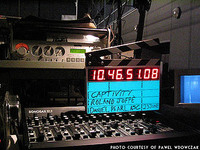![]() Over the past several years, it has become ever increasingly common to record production tracks with a SMPTE timecode reference instead of the traditional 60 Hz sync pulse. This article is intended as an introduction and overview of the use of SMPTE timecode in conjunction with audio recorders.
Over the past several years, it has become ever increasingly common to record production tracks with a SMPTE timecode reference instead of the traditional 60 Hz sync pulse. This article is intended as an introduction and overview of the use of SMPTE timecode in conjunction with audio recorders.
Types of Timecode: Non-Drop vs Drop
 The original timecode system is known as non-drop frame, since it assigns a progressive number to every video frame (0-29). This is an accurate way of tracking individual frames, but caused a problem for video editors when they compared elapsed "real time" to "videotape time". Due to the fact that video actually runs at 29.97 frames per second and NOT 30 frames, editors discovered that they could be off by 3.6 seconds at the end of a one hour show.
The original timecode system is known as non-drop frame, since it assigns a progressive number to every video frame (0-29). This is an accurate way of tracking individual frames, but caused a problem for video editors when they compared elapsed "real time" to "videotape time". Due to the fact that video actually runs at 29.97 frames per second and NOT 30 frames, editors discovered that they could be off by 3.6 seconds at the end of a one hour show.
In order to "synchronize" the clocks on the wall with the elapsed time counters in the edit system, video engineers developed drop-frame timecode, which works sorts of like a leap year in reverse. Two frame numbers are dropped or skipped every minute, except when the number of the minute ends in zero, such as minutes 00, 10, 20, 30, etc.
It is important to realize that the video frames themselves are not deleted. Only their numerical labels are affected.
Frame Rates
The standard timecode frame rate for SD or broadcast video is 29.97 fps. So called 24 fps (video) and most HD is actually 23.976 fps --NOT actual 24 fps. However, video shot with the intent of converting to film could actually be true (native) 24 fps.
Other rate options for film cameras include 24, 25, and 30 fps.
